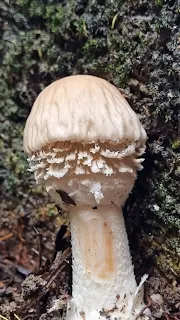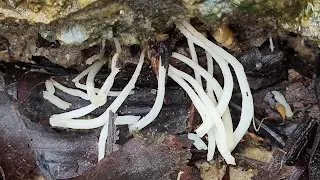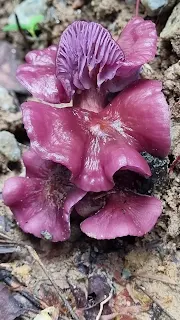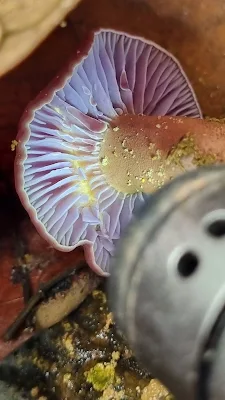Fungi in the Forest: Stinkhorn Mushroom Hunt at Bukit Kerinchi
Kerinchi Hill Forest Park, also known as Bukit Kerinchi, is a lovely urban oasis nestled in Lembah Pantai, Kuala Lumpur. This park is part of the Bukit Gasing Forest Reserve and it is a fantastic spot for jogging, hiking, or just hanging out with friends and family. Because of its natural beauty and amenities, it makes for a perfect venue for community events focused on raising awareness about fungi, as well as fostering appreciation and conservation efforts.
On April 5th, 2025,
the Malaysian Nature Society Selangor Branch Mycology Special Interest Group
(MNSSB Mycology Group) organized a fungi-guided walk themed “Stinkhorn Mushroom
Hunt” at the forest park. The event was led by Loon Yit Hong and 23 members
that consisted of fungi enthusiasts and citizen scientists. The team explored
the main access trail which covered a total distance of approximately 4.0
kilometers.
The main goal of the
event is to help the public understand, appreciate, and conserve fungi, with a
special focus on the fascinating Phallaceae family of fungi. It also provides
comprehensive education, innovative research and community engagement which makes
mycology accessible to everyone.
MNSSB Mycology SIG Members : Group
Leader Loon Yit Hong (11th from the left), Committee Members, Jacqueline
Low (9th from the left), Lenny Wong (5th from the right),
Chan Chee Keong (2nd from the left), Alexia Ng (6th from
the left), Luca Pilia (8th from the left), volunteers and
participants.
MNSSB Mycology SIG Members, volunteers
and participants at the entrance of Bukit Kerinchi.
Material
and Method
Survey Area and Data Collection
The survey area was
conducted along the main access trail of Bukit Kerinchi. The 2.5 hours guided
walk was conducted on April 5th, 2025.
Information about the Phallaceae
family and other fungi (including identification, photos, coordinates, size
measurements, description, and ecology) was documented and uploaded to the
iNaturalist platform. Further accurate identification is verified by mycologist1
and expert2.
Results
and Discussions
Despite the guided
walk covering limited area and ended in approximate 2.5 hours, we made a lot of
fungi observations (including a Phallus sp.) and they were successfully
uploaded to iNaturalist platform.
Safety briefing and fungi knowledge
sharing to the participants prior to the walk.
Fungi identification technique and photography
knowledge sharing to members and participants.
Recorded Families, Genera, and Species
Our findings encompass a wide range of
fungal families and genera as summarized followed.
Parasitic Fungi
· Invade a living host and obtain
nourishment, often causing damage to function and structure.
· Parasitic fungi can affect plants
and animals alike, with the most striking example being the Cordyceps genus.
Fungi that live on tree hosts are also called phytopathogenic fungi.
· The phytopathogenic fungi found in this foray is Rigidoporus
microporus. It is a well-known fungal pathogen, causing white root disease
on living trees.
Rigidoporus
microporus on
a young unknown tree as host.
(Photos by: Loon Yit Hong)
Ectomycorrhizal Fungi (EMF)
· Important part of forest
ecosystem, and almost all trees can form symbiotic relationship with Ectomycorrhizal
Fungi (EMF)
· EMF obtained carbon source
(carbohydrates) from their plant host / partner. In return, they will provide
water and mineral nutrition to their plant host
· With their huge mycelia network,
EMF able to access to the resources that is sometimes difficult to access by
the plant roots.
· The EMF fungi found in this foray
is Entoloma sp. Some species in the genus are known to form ectomycorrhizal
relationships with some trees while most species are saprotrophic (obtaining
nutrients from dead organic matter).
(Photos by: Loon Yit Hong & Luca Pilia)
Phallaceae (Stinkhorns) fungi are saprophytic
fungi that thrive in places where organic matter is breaking down, like rotting
wood, fallen leaves, mulch, or wood chips. They play a crucial role in forest
ecosystems by breaking down this material and recycling nutrients for plants
and trees.
The guided walk is called the “Stinkhorn Mushroom Hunt” because it’s quite rare to spot these mushrooms in the forest, making it a lucky find if you do. Most people aren’t familiar with them, aside from their rather unpleasant smell. The main aim of this event is to help everyone understand, appreciate, and conserve fungi, especially the intriguing Phallaceae family.
Phallus sp.
(Pink Veil Stinkhorns)
(Photo by: Loon Yit Hong & Luca Pilia)
Saprophytic Fungi
A poisonous
Clarkeinda trachodes that
stains red on its stipe when scratched.
(Photo by: Loon Yit Hong)
Clavaria
sp. (Coral-like fungi) that bio-florescent blue under UV lights.
(Photo by: Loon Yit Hong)
Pseudobaeospora
lilacina that bio-florescent blue on its gills, yellow on
its stipe context when cut, under UV lights.
(Photos by: Loon Yit Hong)
Unknown
mushrooms that bio-florescent blue on its gills but not on its stipe context
when cut, under UV lights.
(Photos by: Loon Yit Hong & Luca Pilia)
Laccaria
sp.
(Photos by: Loon Yit Hong & Jacqueline Low)
Gomphaceae family fungi, Climacodon dubitativus (Cauliflower-like Fungi) and Geastrum mirabile
(Earthstars Fungi)
(Photos by: Loon Yit Hong & Jacqueline Low)
Conclusions
Acknowledgement
Jacqueline Low (MNSSB Mycology Committee Member)
Chan Chee Keong (MNSSB Mycology Committee Member)
Lenny Wong (MNSSB Mycology Committee Member)
Alexia Ng (MNSSB Mycology Committee Member)
1Luca Pilia (Mycologist & MNSSB Committee Member)
2Joseph Pallante (Amateur Mycologist)
Malaysian Nature Society Selangor Branch (MNSSB)
Event volunteers: Kho Wui Kiong, Khor Hong Beng, Jerry Yap and Tan Gim Siew.
Wong Wei Fong, Leong Hon Yuen, Yoke Moy, Ho Wai Kuan, Lee Wah Hung, Constant Teo, CK Than, Muhammad Farid, Lee Chong Ho, Hairul Abdullah, Lucy Wong Zi Ni, Ammar Rahimin and their families participated in the event.































Comments
Post a Comment